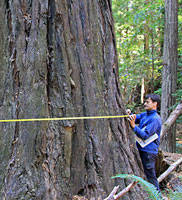The importance of preserving redwood forests is at the fore again as researchers find the ancient trees store up to triple the carbon of other trees.
The multi-year study also concludes that changing environmental conditions are triggering an unprecedented growth surge in coastal redwoods and giant sequoias. The fastest growing tree is adding 1.6 cubic meters of wood a year.
"The redwoods’ ability for carbon storage is the big message here," Richard Campbell, Conservation Science Manager at Save the Redwoods, told The Huffington Post. "It’s not so much what effect climate change has on these trees, but rather the effect these trees have on climate change."

The study, the Redwoods and Climate Change Initiative, began in 2009 and is a collaboration among the Save the Redwoods League and scientists from UC Berkeley, Humboldt State University, Marine Conservation Institute and other organizations.
Only 5% of the world’s ancient redwood forests are left. The oldest coastal redwood is 2,520 years old.
"These results bolster our mission to protect redwoods because these trees are pulling incomparable amounts of carbon dioxide out of the atmosphere which helps combat global warming," says Emily Burns, Director of Science for Save the Redwoods League. "We have found ancient forests where climate conditions are accelerating growth and we predict these places will stay vibrant habitat refuges for other plants and animals in the foreseeable future."
California summers are warming, but rainfall has not significantly changed during recent decades. Researchers predict the northern part of the coast redwood range is likely to be the place where the fewest climate changes occur in the redwood region over the next century and may the best refuge for coast redwoods and the plants and animals that depend on these giants.
Redwood height growth slows with age, but redwood volume growth increases, meaning older redwoods produce more wood every year than younger redwoods.
Researchers found chemical signals within tree rings that reveal what type of climate factors influence wood production in redwoods. They found that warm, dry conditions cause redwoods to conserve water which limits photosynthesis.
The study continues for at least 10 more years to learn how climate affects the growth and survival of redwood trees of all ages (from seedlings to ancients) throughout their ranges. Another goal is to track changes in plants that live in old-growth redwood forests.
"What we’re really wondering is, how long can it be sustained?" UC Berkeley researcher Todd Dawson told KQED. "As climates get warmer and potentially as snowpack declines and precipitation changes, are we going to hit some sort of a tipping point where all of the sudden new growth begins to decline and trees begin to decline?"
In 1850, there were nearly 2 million acres of ancient coast redwood forests in California.
